748.1 Evaluation of Project Impacts
Contents
748.1.1 Evaluation of Risk
The design of all hydraulic structures should include an evaluation of the potential for hydrologic and hydraulic impacts to the roadway and surrounding properties. The evaluation of risk is a two-stage process:
748.1.1.1 Risk Assessment
The initial step, identified as risk assessment, is a qualitative analysis of the potential risk involved with the drainage structure. This evaluation should include particular attention to the following risks:
- lack of a practicable detour
- hazard to people
- hazard to surrounding property
748.1.1.2 Risk Analysis
If the evaluation of potential hydrologic or hydraulic impacts indicates a potential exists for "unreasonable" damage to occur, a risk analysis should be performed. The risk analysis will consider damage to the roadway structures and embankments, damage to surrounding properties and traffic related losses, and will determine an appropriate balance between increasing the cost of the project and decreasing the risk of hydraulic impacts. Procedures for conducting a risk analysis are included in the FHWA HEC-17 publication Design of Encroachments on Floodplains Using Risk Analysis. Contact GHQ Design for additional guidance in performing a risk analysis. The evaluation of potential hydrologic and hydraulic impacts, as well as the risk analysis, if one is performed, shall be retained with the project file.
748.1.2 Hydrologic Impacts of Roadway
Development such as a highway project can affect the hydrologic characteristics of a watershed. Such development typically increases the amount of impervious area within the watershed, and may also decrease the time of concentration of the watershed. Both of these effects tend to increase both the volume and peak rate of runoff from the watershed. The magnitude of this increase is generally dependent on the ratio of the developed area (pavement and right of way in the case of highway projects) to the total watershed drainage area. When the developed area is a large percentage of the total drainage area, the impacts can be significant. The degree of hydrologic impact shall be subjectively evaluated for all highway projects; when the impacts are estimated to be of concern, a detailed analysis shall be performed. Significant increases in peak flow rates shall be mitigated through the use of detention storage or other appropriate measures.
748.1.3 Hydraulic Impacts of Bridges and Drainage Structures
For each drainage structure, an evaluation should be performed to compare the general hydraulic conditions of the area before and after the proposed improvement is made. This evaluation should consider increases in peak flow rates, flow velocities and water surface elevations as well as changes in drainage patterns before and after the proposed improvement is made. With the results of this evaluation, a determination can be made concerning the flood damage potential to adjacent properties as a result of the proposed improvement.
Evaluation of the consequences of risk associated with a stream crossing considers capital cost, traffic service, environmental and property impacts and hazards to human life. The risk assessment should consider damage to structures, embankments, and surrounding property, traffic related losses, and scour or stream channel change.
748.1.4 Common Drainage Complaints
Listed below are several common causes for drainage complaints by landowners. Consideration should be given to minimizing or eliminating, to the extent practical, these causes for complaint:
- Diversion of flow from one watercourse to another
- Collection and concentration of surface waters
- Augmentation of flow peaks or volumes
- Obstruction of flows resulting in increased backwater
- Erosion and sedimentation
- Groundwater interference
